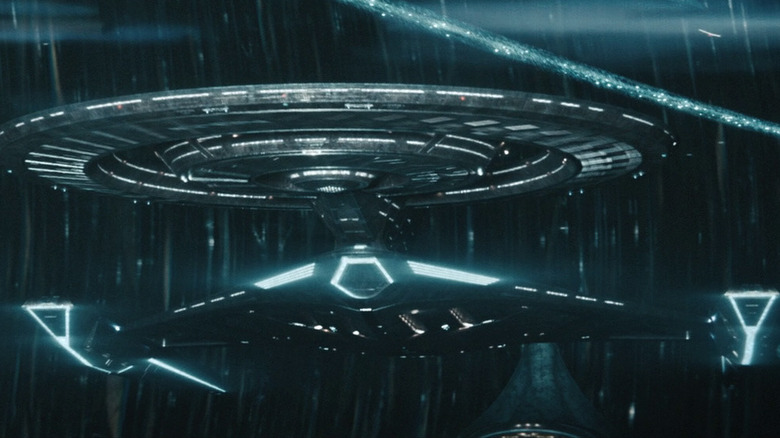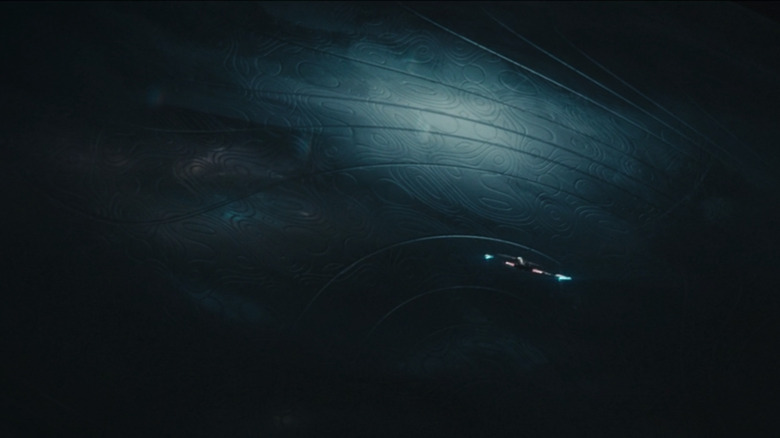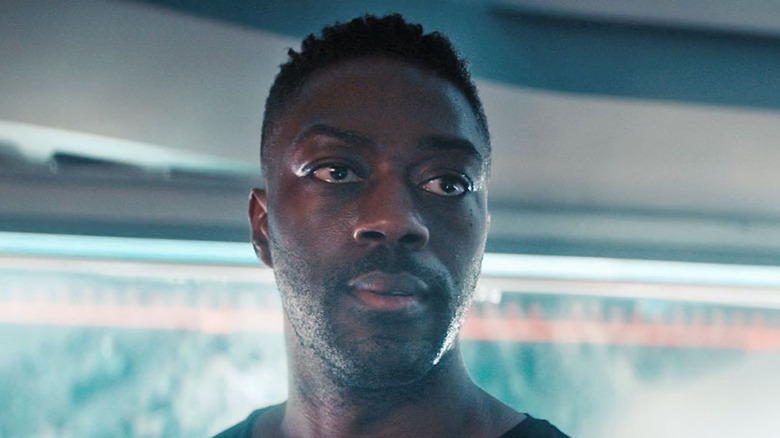The Biggest Unanswered Questions From Star Trek: Discovery Season 4
This season on "Star Trek: Discovery," Captain Michael Burnham and her crew investigated the Dark Matter Anomaly, a mysterious cosmic force whose gravity waves shatter worlds and threaten billions of lives. When it turns out that the anomaly is not a natural phenomenon, but a mining tool used by an incredibly powerful extragalactic force, Burnham and some of the Federation's best and brightest set out on a dangerous quest to make contact with its creators, who they call Unknown Species 10-C. Burnham's diplomatic mission puts her at odds with her partner, Cleveland "Book" Booker, whose home planet has already been destroyed by the Dark Matter Anomaly. While Burnham pursues peace, Book prepares for war, teaming up with rogue scientist Ruon Tarka on a mission of their own: To disable the anomaly's power source and end its immediate threat. However, this action would almost certainly provoke open conflict with the 10-C.
The climactic season finale put everything on the line — the peace effort, Burnham and Book's relationship, and Earth's very survival. The episode tied up the 13-part story arc nicely, leaving behind very few loose ends, while keeping the future of the series wide open. So what might be in store for "Discovery" fans in the upcoming fifth season? Hopefully, we'll get the answers to a few questions we still have.
SPOILERS AHEAD for the "Star Trek: Discovery" Season 4 finale, "Coming Home."
What else lies beyond the Galactic Barrier?
This season of "Discovery" went boldly where "Star Trek" has rarely gone before: Beyond the edge of the Milky Way Galaxy. Previously, Federation starships that have dared to approach the Galactic Barrier have been either destroyed or forced to turn back, with their only successful trips across the border being the products of alien interventions or unrepeatable accidents. In Season 4, the USS Discovery employs programmable anti-matter to successfully cross the strange (and entirely fictional) energy membrane that separates the Milky Way from the rest of the universe and encounter new lifeforms that have never before been seen on "Star Trek."
Now that Starfleet has developed a reproducible method of leaving the galaxy, their charter to expand their understanding of the universe demands that they reach out into the unknown, not only to the space surrounding the Milky Way, but to other galaxies. The space between our galaxy and its nearest neighbor, Andromeda, is more than 23 times the diameter of the Milky Way and would take centuries to cross, but someone will have to take the first steps toward this new frontier. Might this be a job for the USS Discovery? Or perhaps the USS Voyager-J? She certainly wouldn't be the first ship of her name to embark on an incredibly long journey, and her fuel-efficient prototype "pathway drive" could be just what they need to venture out into the starless depths of intergalactic space.
What is the future of the spore drive?
The USS Discovery and her ill-fated sister ship, the Glenn, were commissioned in the mid-23rd century as test laboratories for the displacement-activated spore hub drive, an experimental propulsion system that would allow a vessel to travel instantaneously between two points through an extra-dimensional network of cosmic fungus. Discovery takes the only working model of the drive on her one-way trip to the 32nd century, where Federation scientists of the future have begun to reverse-engineer it. Starfleet Admiral Vance places the mad genius Ruon Tarka in charge of the project, and he successfully creates a compact spore drive that can be plugged into any starship. It's last seen on Book's ship, which is destroyed (along with Tarka) when it collides with the 10-C's hyperfield in the season finale.
With both the spore drive prototype and its engineer lost, the Federation is now back to square one. Assuming her own drive is repaired (as is implied in the finale), Discovery is once again the only Starfleet vessel able to instantly respond to crises across the galaxy. Will another scientist be able to reproduce Tarka's work? Moreover, will the next model surpass the limitations of its predecessors, which require a living operator with a psychic connection to the mycelial network? There are only two known beings who can operate the drive's current version — Commander Paul Stamets, who serves aboard Discovery, and Cleveland Booker, who has just been sentenced to an indefinite amount of community service.
What is the 10-C protecting itself from?
Until the end of the season finale, Unknown Species 10-C resides in a star system protected by a massive energy bubble called a hyperfield. The hyperfield measures 1.5 AUs in diameter (about the size of Mars' orbit) and requires large amounts of the potent element boronite to maintain. It's so hungry for boronite, in fact, that the 10-C employ a mining device 5 light-years wide — the Dark Matter Anomaly — to gather enough fuel to keep it running. As far as the crew of Discovery can tell, the hyperfield is totally impenetrable without an invitation inside.
We don't know much about the 10-C, other than that they used to reside on a gas giant that was rendered uninhabitable by a series of asteroid collisions. The hyperfield is likely their recourse against a similar horrible fate befalling their new home, but the odds of another such accident occurring are infinitesimal, unless they have reason to believe some intelligence wishes them ill and plans to throw more space rocks at them. In actuality, there's probably no literal threat to justify the 10-C's shield — it's a metaphor for fear of the unknown and resistance to change, communication, and empathy. The 10-C cloister themselves in fear, but remain blind to the terrible damage they themselves are doing. By dropping their shield, as they do at the end of the season, they accept that their desire for safety does not justify ignoring or infringing upon the safety of others.
Does Michael Burnham have a future in politics?
At the start of Season 4, Captain Michael Burnham meets the new President of the United Federation of Planets, Laira Rillak, and the two immediately butt heads. Burnham has little patience for Rillak's political niceties, and Rillak has reservations about Burnham's savior complex. Over the course of the Dark Matter Anomaly crisis, however, the two gain a much better understanding and appreciation of each other's skills, and a bond forms between them. It would be an exaggeration to call Rillak Burnham's new mentor — it's more of a two-way street — but by the end of the season, Rillak sees Burnham's great potential. Later, when United Earth's president comes aboard Federation HQ to declare her intention to rejoin the Federation, she asks for a moment to speak with Burnham alone. The captain has clearly become a favorite among elected leaders and is much more comfortable working with them.
Although Burnham has only just begun her tenure as a starship captain, the more time she spends with the big movers and shakers of the galaxy, the more likely she is to get drawn into political life. No previous "Star Trek" captain has ever had the ear of so many high-ranking officials, and one of them is bound to try and cash in on her seemingly limitless potential as a leader and diplomat — not that we'd expect her to take them up on it until the end of the series.
Did Tarka make it to his paradise dimension?
Ruon Tarka has spent the past decade searching for an energy source strong enough to power his interdimensional transporter, which he believes will take him to a peaceful universe called Kayalise. His obsession with traveling there and reuniting with his only friend, Oros, leads him to make dangerous, even monstrous decisions. When he discovers that the device that powers the 10-C's Dark Matter Anomaly is sufficient to make his transporter work, he dedicates himself to stealing it, no matter the cost. He's willing to provoke a war with the 10-C and trigger a massive ecological disaster in Federation space in order to get what he wants. In the season finale, Discovery and United Earth General N'doye foil Tarka's plan to capture the power source, which sends his ship spiraling towards the 10-C's hyperfield. Before he perishes, Tarka reconfigures his transporter in the hope that the impact with the hyperfield might be enough to fuel his multiversal journey. We only see the crash from afar, leaving Tarka's final fate a mystery.
Tarka doesn't really deserve a happy ending (and by the end of the story, he knows it), but we can't help being curious as to whether or not his gadget worked. It's not a question we expect any future episode to answer — one way or another, we've likely seen the last of Ruon Tarka.
Is Tilly getting a spin-off?
Early in Season 4 of "Star Trek: Discovery," in the episode "All Is Possible," Lieutenant Silvia Tilly accepts an invitation from Starfleet Academy to lead a trio of cadets (and Discovery's Ensign Adira) on a training mission. Though the mission goes sideways and turns into a life-or-death situation on an inhospitable planet, Tilly finds the experience deeply fulfilling and decides to depart Discovery to become a full-time instructor. She's absent from the rest of the season, except the finale, in which she once again leads her cadets and assists Admiral Vance in buying Starfleet's rescue ships time to escape the Dark Matter Anomaly's radius.
There's been no word from "Discovery's" producers or from Tilly actor Mary Wiseman regarding her departure from the series, and it's possible there are no long-term plans for her character. However, according to Deadline, CBS Studios is currently developing a new "Star Trek" spin-off centered around Starfleet Academy. There's no guarantee the series would feature Lieutenant Tilly or even take place in the same century as "Discovery," but it wouldn't be the first time a character was written off the series with a spin-off in mind — Michelle Yeoh's departure in Season 3 was the launchpad for a show of her own, which is still in development. A Starfleet Academy series would likely focus on the students more than the faculty, but if it's set in the 32nd century, there could certainly be a place for Tilly to appear as a regular or recurring character.
How much will Book be around next season?
For the span of a few minutes in the Season 4 finale, it looked like it was curtains for Cleveland Booker, the charming star courier who won the heart of Captain Michael Burnham. Thanks to a surprise save by the 10-C, Book survives the destruction of his vessel and convinces the aliens to disable their Dark Matter Anomaly device for good, saving the populations of Earth, Titan, and NiVar from certain death. This doesn't erase the crimes he committed with Ruon Tarka while on his unsanctioned mission to disable the anomaly, but the Federation factors in his understandable motivations when determining his fate. Book is sentenced to a form of community service he'd likely have volunteered for anyway, assisting the relief and relocation efforts for communities displaced by the Dark Matter Anomaly, which his actions inadvertently intensified. This will, however, take him away from Captain Burnham for an unspecified period of time.
Booker has been a regular character on "Discovery" for two seasons, but it's unknown what size role he'll play in the next. The finale leaves plenty of possibilities for Booker's future, as his relationship with Burnham is still intact and he will presumably regain his freedom after the relief mission is completed. Booker could return to Discovery after the end of his sentence, once again becoming a regular character, or merely recur, returning to his courier career or beginning some new chapter in his life.
Will Gray return to Discovery?
When Gray Tal makes his debut in early Season 3, he's just a ghost in the head of his partner Adira, who has become the new host of the Tal symbiont. His own body has already been dead for years, and it's only through a bizarre quirk in Adira's connection with the symbiont that Gray can even continue to exist. During Season 4, however, Gray finally incorporates into a new synthetic body, allowing him to interact with the rest of the crew and pick up his life where he left off. Gray remains aboard Discovery for a few weeks, but departs halfway through the season to resume his training as a Trill Guardian. We see that Adira makes a trip to visit him on Trill and speaks of him often, but he makes no further appearances after leaving the ship.
Gray's actor, Ian Alexander, is credited as a guest star on "Star Trek: Discovery," but is nevertheless a prominent member of the ensemble who has been at the center of a longterm story arc. It would be very surprising if Gray made no further appearances on the show. However, now that he has a body and a life of his own, there's less of a reason for him to be around on a regular basis. Unless Season 5's story arc provides a good excuse for him to make an extended stay aboard Discovery, it's possible that Gray will be less present going forward.
Will Saru accept a new command?
For most of Season 3 of "Star Trek: Discovery," Captain Saru serves as commanding officer of the show's titular vessel. After the crew of Discovery solves the mystery of the Burn, Saru takes a leave of absence to his home planet, Kaminar, leaving the center seat open for his newly promoted first officer and closest friend, Michael Burnham. At the start of Season 4, Saru is offered a new command, but turns it down so he can be by Captain Burnham's side during the Dark Matter Anomaly crisis. Saru serves as first officer for the duration of the season, going by "Mr. Saru" rather than by his rank to avoid confusion. (This is not without precedent — Kirk, Spock, and Scotty all held the rank of captain simultaneously while serving together aboard the USS Enterprise-A.)
Burnham and Saru have a wonderful working relationship and would likely be content to serve together indefinitely, but Saru has not ruled out a return to the captain's chair. Now that the danger of the anomaly has passed and Burnham has survived the first serious test of her captaincy, she could likely get by without him if he chose to move on, though at the moment he's probably more concerned with exploring the new development in his private life: A relationship with NiVar President T'Rina. Between this new romance and his role as a member of Kaminar's ruling council, it's hard to imagine him taking on even heavier Starfleet duties.
Will Federation HQ remain above Earth?
This season's finale reveals that Federation Headquarters, which has appeared to be a space station, is actually a warp-capable starship. In order to participate in the evacuation of Earth, Fed HQ changes shape and travels to the Sol system, taking position in Earth's orbit. After the crisis has passed, it's still there, re-morphed into its familiar shape as a stationary base. At the end of the episode, United Earth officially rejoins the Federation, and the fleet seems to be gathering peacefully above Earth, like they did back in the 23rd and 24th centuries. This heavily implies that Starfleet and the Federation have permanently moved their base of operations back to Earth, which has served as the seat of its power during every other era in Star Trek's history.
Ever since Discovery arrived in the 32nd century, her mission has been to help restore the idealistic United Federation of Planets to its former glory as a symbol of galactic peace and cooperation. Countless worlds have returned to the Federation since Captain Burnham and her crew uncovered the truth about the disaster that tore the galaxy apart, and the Federation is still the Federation, whether or not Earth is a member. However, there is no greater symbolic victory for Burnham and Federation President Laira Rillak than welcoming United Earth back into the institution they helped to build. It essentially allows the Federation itself to finally come home.










